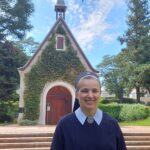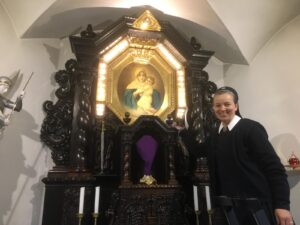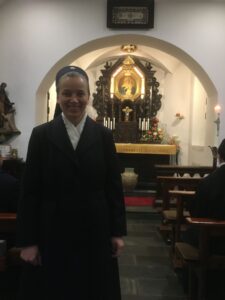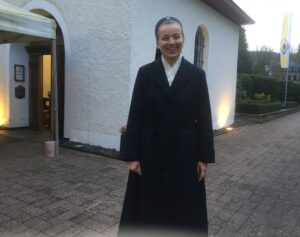
Every member of Schoenstatt has the great dream of visiting the Original Shrine, the place where it all began. It is impressive to see people from Brazil arrive at the shrine for the first time; there are often tears when that for which they waited such a long time becomes reality. This is how it was for Sister M. Vanda Friedrich from the state of Santa Catarina, Brazil. She belongs to the Schoenstatt Tabor province whose headquarters is in Atibaia/SP, Brazil. She could hardly believe that she was experiencing the Original Shrine … But God had something else yet planned for her: For six years now she is busy almost the entire day with this shrine, because she is the sacristan of the Original Shrine. She herself says that this is a great privilege.
In February, Sister M. Vanda was on vacation in Brazil and allowed us to interview her before her return to Germany.
Sister M. Vanda, you live in Schoenstatt, Germany and now are on vacation in Brazil, from one Tabor to another Tabor. When you are in Schoenstatt, Germany, how do you view Schoenstatt in Brazil?
When I look at Schoenstatt in Brazil, I see it as a family united in the Tabor ideal from the north to the south of the country. Schoenstatt in Brazil is vibrant, dynamic, involved and active in the Church, especially through the Apostolate of the Pilgrim MTA, as seldom experienced in other countries. Schoenstatt is flourishing and offering much to the Movement as a whole. In summary: Schoenstatt in Brazil is vibrant, young and dynamic.
How do you feel as sacristan of the Original Shrine?
I feel very privileged, even though I do not deserve the grace to work directly and concretely with the Blessed Mother every day and to receive pilgrims and people who want to visit her. It is a challenging task because it is a place of international pilgrimage, as the Original Shrine should be. But it is also very rewarding to be able experience history in such a concrete way and experience the development, to accompany the development, of a growing shrine pastoral at our place of origin.
What about the Schoenstatt Movement at the Original Shrine?
Between April and October (spring and summer) is the most life at the Original Shrine because there are more pilgrims, more groups, more meetings in the houses and, thus, more Holy Masses are celebrated during this time. In winter, we have more individual pilgrims, not so many groups, and therefore fewer Holy Masses. It is currently still winter in Europe and we have three Holy Masses each day: at 6:30 AM, 8:00 AM and 4:00 PM. (The last is in Spanish except on Tuesdays when it is in English).
The preparation for the covenant of love with the Mother Three Times Admirable of Schoenstatt takes place in groups, people who prepare themselves and come to seal the covenant of love on a particular occasion; for example, League groups, mothers, couples, youth. There is the possibility of preparing online for the covenant of love and there is an open invitation to come to the Original Shrine and make the covenant of love in person at some point.
A large number of pilgrimages are the missionaries in the various languages: Polish, Spanish, and Portuguese … who likewise seal the covenant of love, and in most cases, are missionaries of the Apostolate of the Pilgrim MTA. There are people, too, who prepare at home and then make a pilgrimage in order to seal the covenant of love in the Original Shrine.
How is the Schoenstatt Family from all over the world represented in the Original Shrine?
In addition to our daily prayers for the Schoenstatt Work in the whole world, there is also the fact that we come from various countries, and the international pilgrimages that come here; we try to represent every country, especially when there is an important date for this country. We represent it by placing a little banner, or a picture, or a symbol that represents this country near the altar. But when we know that a country is going through difficulties, we also remember this in our prayers. In these times of war, for example, we have a picture every day with the word “peace” in different languages, with a burning candle imploring peace. In this way, we try to bring all the people of the respective country and their needs to the Original Shrine and ask the intercession of the Blessed Mother for them.
Each evening we represent all people in the whole world during the evening blessing and we pray for them. In this way everyone is remembered and very often even mentioned. When there is tragic news from a country, we usually bring it up and entrust it to the Blessed Mother.
What are the hours the Original Shrine is open?
The Original Shrine is open every day from 6:00 AM to 8:30 PM. Normally,during these hours, the sacristy is open also to receive pilgrims.
How should a person or group who wants to visit the Original Shrine proceed?
The Info e-mail address of the Pilgrim Information Center or the Portuguese-speaking secretariat can be used to book your visit. It is worth pointing out that we also have guest houses near the Original Shrine.
I say that because, unfortunately, it often happens that pilgrims come to the shrine but stay in hotels in the vicinity. That makes it difficult to come to the Original Shrine or even shortens the time available to enjoy the graces of the Original Shrine.
It is important to know that at this place of grace there is not only the Original Shrine but other very important historical places such as
– the Founder Chapel, where Father Joseph Kentenich is entombed,
– the Father-Kentenich House, where original objects from time periods can be viewed and one can learn about the various stages in Schoenstatt’s history,
– the Schulungsheim, the residence of Father Kentenich,
the centers and shrines of the different communities in Schoenstatt and many other places.
The Schoenstatt-Info offers a guided tour of each of these places.
If one only comes only for a few hours or cannot stay longer, this shortens the opportunity to linger in the places of grace and receive graces.
Contact Schoenstatt-Info:
E-Mail: port@schoenstatt-info.org
Website: schoenstatt-info.com


